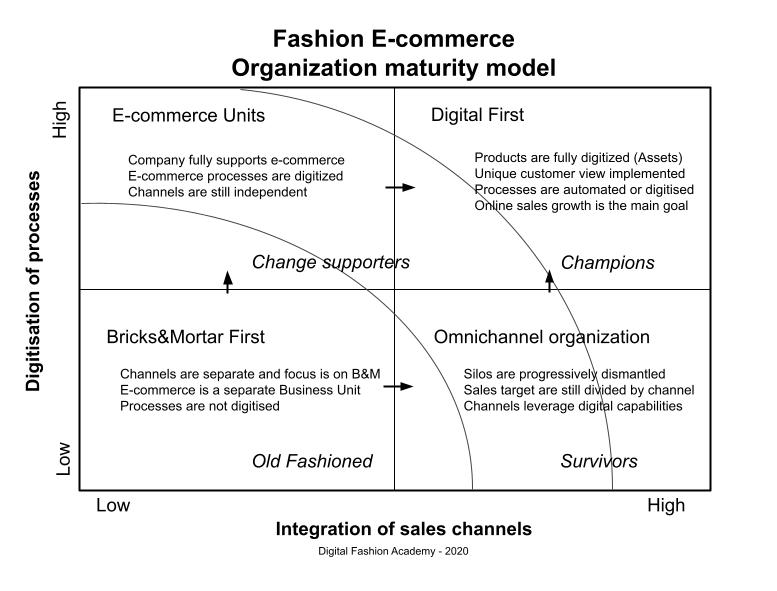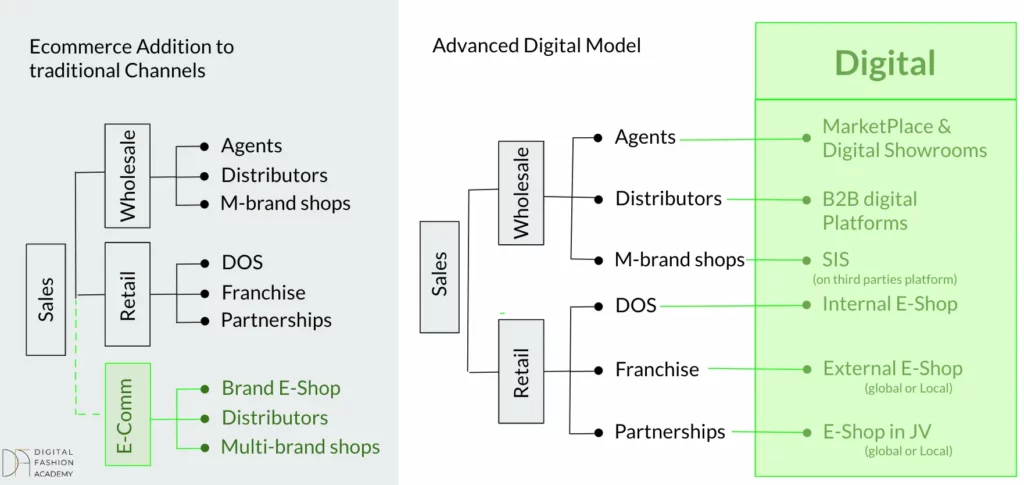Digital transformation has been on the agenda of Fashion companies for a few years now, however even the large players with immense financial resources are struggling with this transformation process.
The biggest issues for fashion companies when dealing with digital transformation:
- The top management is not trained on Digital Management
- Decisions are not yet sufficiently based on data.
- Need for investment in technology
- Need to structure the Organization and processes
What are the benefits and risks from digital transformation?
Benefits:
- More efficiency: this means saving money and increasing margins both from sourcing products and also from operating expenses, therefore increasing the EBITDA
- Improved quality of decisions: decisions will be based on accurate data and more up-to-date or real time data
- Streamlined processes: with digital transformation processes need to be clearly defined step-by-step.
Risks
- Need for re-training Senior Management: workers with an old-fashioned mentality may not be able to adapt easily
- Need for change: the implementation of a transformation process will require change working habits
- Employees resistance: people who have worked with the same methodology for several years may oppose the change and jeopardize the digital transformation process
How to deal with the risks of digital transformation?
In order to favour the adoption of digital best practices it’s necessary to adopt an incremental approach, with the goal of moving the organisation through a maturity growth in digital capabilities. The company growth can be achieved by providing training and coaching to the people involved in the transformation.

What are the enablers for the digital transformation in fashion companies?
The are some conditions that are necessary to start a digital transformation process, such as
- availability of digital skilled personnel,
- a management team motivated to change the organization
- budget for investment in IT solution, especially cloud and AI
How to implement digital transformation in fashion industry:
In order to successfully implement Digital Transformation in fashion brands and retailers, Fashion companies should focus on some specific transformative goals:
- Be customer centric: les marques de mode doivent construire l'expérience autour du parcours client and focus on how to implement the customer satisfaction, read more about this in this article “unlocking customer satisfaction“.
- Prise de décision en temps quasi réel: fashion brand should use analytics and business intelligence to make effective decisions rapidly;
- Management par objectifs et non par processus: chaque processus doit avoir un KPI mesurer les résultats;
- Apprendre à apprendre: companies should incentivate the ability to learn of their employees, for example making a catalog of relevant courses accessible to employees and rewarding the effort of employees to keep developing professionally and training.
Certaines entreprises de l'habillement, de la mode et du luxe ne survivront pas à la crise actuelle ; d'autres en sortiront mieux positionnés pour l'avenir. Cela dépendra beaucoup de leurs capacités numériques et analytiques. […] Bien que personne dans l'industrie n'ait prévu l'intensité de cette crise, certaines entreprises de mode se trouvent mieux équipées que d'autres, en grande partie grâce à leur savoir-faire numérique.
McKinsey – Fashion digital transformation
How to implement effective training programs for employees in the fashion industry
At Digital Fashion Academy we have worked hard to create the most advanced training program in Fashion Business Management adopting the most flexible solutions for our students. But we didn’t stop there, we also adopted the digital solutions for training that allow our students to interact with each other like they were physically present in the room and more.
Our approach requrires students to work together to build strategies and plans, priorities projects and analyse performance of fashion brands.

During the lessons the students are also challenged to examin real life situations and discuss them to understand how things work in the complex world of fashion.

Acceleration and Deceleration of Digital Transformation
La crise pandémique a accéléré un processus de transformation numérique qui aurait mis des années à s'accomplir. Cependant seules certaines activités de l'organisation des entreprises de mode peuvent être réellement transformées numériquement en quelques semaines. Par exemple, les employés ont bien accepté le changement de leurs habitudes de travail en passant du bureau à leur domicile, et les entreprises et les gouvernements ont été heureux et proactifs d'accompagner ce changement en facilitant par exemple toutes les situations dans lesquelles les parents-travailleurs travaillaient à domicile et s'occupaient de leurs enfants en même temps. La chaîne d'approvisionnement n'était pas prête à être transformée numériquement et la production d'échantillons et la livraison de la collection ont été affectées négativement par la crise pandémique.
Ce qui a vraiment changé en quelques jours au début de la crise pandémique, c'est le comportement des clients. Le client est rapidement passé des magasins Bricks and Mortar aux sites Web de commerce électronique. Chaque fois qu'ils avaient besoin d'acheter quelque chose pendant la pandémie, ils pouvaient l'obtenir en ligne et le livrer à domicile. Bien sûr, les besoins étaient également différents et, par conséquent, certaines catégories de produits ont été pénalisées et certaines ont connu une augmentation de la demande, par exemple le homewear et le loungewear ont augmenté tandis que les accessoires de luxe et de voyage ont diminué.
Les prochaines étapes de la transformation numérique de la mode
Les défis qui nous attendent ne sont pas clairs, mais nous pouvons tirer quelques leçons de cette crise :
- La transformation numérique doit se produire dans toutes les activités de la chaîne de valeur, de la conception des produits à la vente au détail
- La transformation numérique doit être régie par les PDG et les chefs d'équipe interfonctionnels
- L'infrastructure technologique d'une entreprise est un atout concurrentiel et peut déterminer un avantage concurrentiel
- Les modèles organisationnels du siège social et du commerce de détail doivent être flexibles et malléables
- Les compétences analytiques, les compétences numériques et les compétences humaines sont essentielles au succès des entreprises de mode
Le bilan de la transformation digitale de votre entreprise
If you are interested in the digital transformation process of your company, you can take the digital transformation self assessment for free here: test de transformation numérique.
Avant la crise pandémique, les entreprises de mode pouvaient poursuivre leurs activités comme elles le faisaient depuis 20 ans ou plus. La chaîne d'approvisionnement fonctionnait bien et était intégrée au niveau mondial, la distribution se développait avec une nouvelle forme d'expérience de vente au détail traditionnelle et les employés des marques de mode travaillaient plus ou moins efficacement et avec bonheur dans les entreprises de mode.
Then, all of a sudden the pandemic crisis has disrupted the majority of fashion retailing processes in a matter of weeks: supply chains from China stopped working, departments stores and shopping centres closed their doors and employees have been forced to work from home.
It’s not possible to give a yes or no answer to this question, but we see that the companies who are investing in digital resources hiring digital savvy people and implementing digital projects can achieve their goals more effectively than the companies that aren’t investing in digital solutions.

